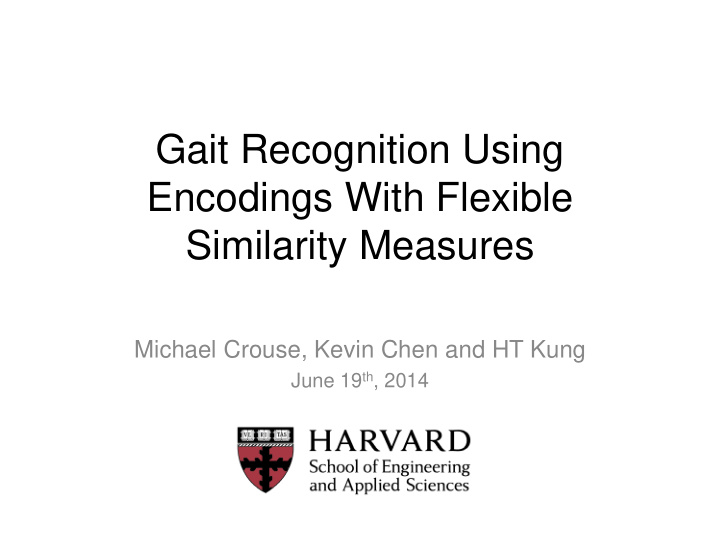



Gait Recognition Using Encodings With Flexible Similarity Measures Michael Crouse, Kevin Chen and HT Kung June 19 th , 2014
New Opportunities in User Identification Inspired by the Internet of Things • IoT provides unique opportunities: volume and diversity of personal sensor data • These sensors can passively and continuous extract information useful for identifying users Project Tango Smart Phones – This could represent an improvement over traditional approaches for identification and authentication • Biometrics such as face and fingerprints are promising approaches 2
Gait Recognition – An Ideal Biometric for IoT-based Authentication • Gait is an action that people do naturally, every day that is also characteristic to each individual • Furthermore, gait signals can be can be measured using a variety of sensors with many advantages: – Measurements can be taken passively on ubiquitous devices – Difficult to mimic – Gait is cyclic and measurements are small – this allows for efficient classification of user gait signals 3
Feature Space Encoding for Improved Separability • Use a dictionary, D , of examples (atoms) – D i – The feature space representation for a candidate, x , is the measure between it and each atom in the dictionary: • Feature encoding provides robustness to expected variations within classes f i = Similarity ( D i , x ) D i = … , f i x D 4 f
Convolution Similarity for Sequence Alignment • A discrete convolution between two signals, f and g as: Convolution similarity is: • Reduces the necessity of finding every step within gait signal by determining the best alignment of segments This does not handle stretching and local shifting (but still useful!) 5
Data Augmentation for Improving Convolution Similarity One way to improve convolution measure is to augment dictionary atoms with stretched and compressed versions – This is a simple but brute force way of providing additional invariance for the feature encoding Original Stretched Compressed 6
Dynamic Time Warping (DTW): A More Robust Similarity Measure • Dynamic Time Warping is a more robust similarity measure for comparing two time-series sequences – Finds a non-linear warping between two signals using a dynamic program – Allows for the signals to be stretched/compressed for best alignment between significant features 7
Experimental Setup and Dataset • Used an HTC Droid DNA (Android phone) with a custom app to capture sensor data – Device placed in front left pocket , sampled at 50Hz • The human body generally accelerates between -+2 gs, effectively 15-20hz. Nyquist sampling rate for walking with sensor at thigh is roughly 40Hz [1,2] • The experiment consists of each subject performing 4 separate walks, 2 in each direction of path (roughly 30 seconds in duration) – 30+ subjects walked 4 separate times around a predefined route 1 Mathie, Merryn J., et al. 8 2 Marcus Chang
A Gait Recognition Pipeline x y z 4 3 4 Dictionary Atoms (k) 2 3 1 2 ... 1 ... k ... Linear time SVM D X F F = Sim ( D, X ) Raw Data Extract Windows Construct Dictionary Feature Encode and Dimension Reduction 9
Gait Identification Experiments with Under Various Scenarios • Our experimental design is to create several scenarios in order to test several hypothesized variations: – walks on the same day, different days, different paces, different phone orientation Multi-Class Accuracy Results Best Prior 10
Conclusion • Gait is a new, useful biometric that can be used to identify many users (30) with high accuracy – Training samples are simple to obtain and the number of measurements for classification is small • Using a simple linear classifier in feature space with no tuning, high accuracy can be achieved – Tuning the hyper plane and penalty parameters could be done to improve performance further • Scaling to larger numbers of users is possible by considering larger numbers gait cycles and increasing the size the dictionary 11
Future Work • Sensor Fusion – combining many sources of sensor data can further bolster FAR and FRR – Gait is an ideal target because of the simple setup and the regularity at which it occurs for users • Capturing larger and more challenging datasets – Variations between days, pace and other environmental factors need to be explored and at scale (100+ users) – Increase type and location of sensors • Explore how variations between days could be exploited via incremental update of user gait templates for strengthening authentication – Changing pattern could make potential attacks more difficult (less predictable, unique for biometrics) 12
Thank you! Contact Info: Michael Crouse mcrouse@seas.harvard.edu 13
Recommend
More recommend